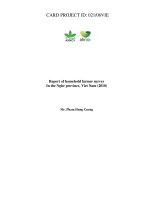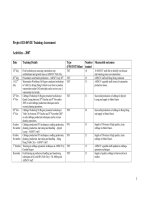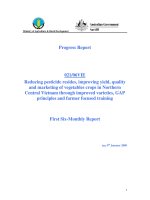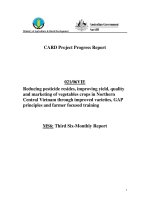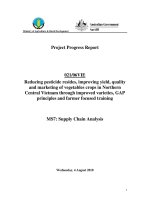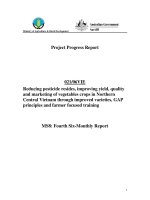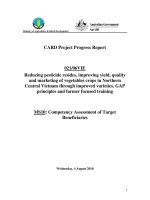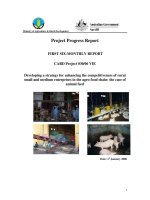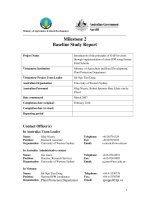Báo cáo khoa học nông nghiệp " Developing GAP systems for dragon fruit producers and exporters in Binh Thuan and Tien Giang provinces " pdf
Bạn đang xem bản rút gọn của tài liệu. Xem và tải ngay bản đầy đủ của tài liệu tại đây (76.72 KB, 10 trang )
GAP Workshop in Binh Thuan (21-22/7/2008)
1
Developing GAP systems for dragon fruit producers and exporters in Binh
Thuan and Tien Giang provinces.
Nguyen Van Hoa
(1)
, Nguyen Huu Hoang
(1)
, John M Campbell
(2)
and Nguyen Minh Chau
(1)
CARD Project 037/04VIE
Starting date: 30 June, 2005 and Ending date: June, 2008
ABSTRACT
In Vietnam, at present, the area for dragon fruit is about 13,500 ha with the
production of about 211,000 tones and the average area per household is 0.5- 1 ha.
Producers of dragon fruit have seen prices for their fruit decline by about 60% since
2000 as the product is mainly sold for local consumption or to neighbouring
countries. Returns from dragon fruit could be significantly improved if small growers
and exporters can gain access to new high value markets in Europe and North
America. The project has established a private sector working pilot of exporter packer
and supplying dragon fruit growers in which the European high value market driven
standards of BRC at the packer and EUREPGAP at the farmer level have been
implemented. Activities included (i) Field farmers’ benchmarking survey completed
and a report was prepared by HortResearch personnel and delivered as a PowerPoint
presentation to SOFRI personnel, also packers, farmers, MARD and DARD personnel
of Binh Thuan in 2007. (ii) Selection of a packer/exporter and farmer group for the
Project Pilot confirmed and formalised. (iii) Training of the Pilot members for
improvement towards British Retailers Consortium: Global Standard – Food (BRC)
for the packer and EUREPGAP for the farmers were carried out to enable them to
reach compliance in all areas. (iv) Pilots both for field production and packhouse
were implemented and all the corrections have been done and the Certification for
EURAPGAP with 80 ha of dragon fruit production has been achieved while the
packhouse are being auditing for BRC certification. (v) The dragon fruit quality
manuals for the farmer and packer were developed in a way that closely related to the
current practices, included appropriate improvements to enable the farmer and
packer to meet compliance with the EUREPGAP and BRC standards, and are user
friendly. (vi) Translation of the Manual into Vietnamese and distribution to the
project the pilot supplying farmers (EUREPGAP “C” section) and to other packers
and farmers progressing GAP production, packing and export. (vi) The national
personnel capacity building within the project team and in the private sector has seen
practical GAP proficiency developed to a high level which will ensure the continued
development of the pilot and the subsequent distribution of the model to many more
small-holder fruit crop producers. (vii) High value markets have been identified and
are due to be tested following Certification of the pilot. (viii) The CARD dragon fruit
project continued to be well publicised in the local and national newspapers and
television during the project implementation.
1. Southern Horticultural Research Institute 2. HortResearch Nelson
PO Box 203 My Tho Old Mill Road, PO Box 220
Long Dinh – Chau Thanh, Tien Giang, VIETNAM MOTUEKA, NZ
Tel: +84 73 834 699 Tel: +64-3-528 9106
Fax: +84 73 893 122 Fax: +64-3-528 7813
I. INTRODUCTION
In Vietnam, at present, the area for dragon fruit is about 12,000 ha with the production
of about 211,000 tones and the average area per household is 0.5 – 1 ha (Nguyen
GAP Workshop in Binh Thuan (21-22/7/2008)
2
Minh Chau, 2007). Producers of dragon fruit have seen prices for their fruit decline by
about 60% since 2000 since the product mainly sells for local consumption or to
neighbouring countries. Returns from dragon fruit could be significantly improved if
small growers and exporters can gain access to new high value markets in Europe and
North America. However, the Vietnamese exporters will need to find alternative
markets for their products. High-value markets of Japan, Europe and North America
have been non-receptive to Vietnamese dragon fruit due to perceptions of poor quality
and lack of legal and food safety accountability. The project (037/04VIE - Developing
GAP systems for dragon fruit producers and exporters in Binh Thuan and Tien
Giang provinces, which was aimed at developing quality systems for export market
access for dragon fruit has established a private sector working pilot of
exporter/packer and supplying dragon fruit growers in which the European high value
market driven standards of BRC at the packer and EUREPGAP at the farmer level
have been implemented. The project was carried out with 2 main objectives:
Objective 1: To increase small holders’ competitiveness and capacity to supply
dragon fruit to high-value international markets, introducing new concepts of food
safety, environmental responsibility, sustainability and worker safety into their
production practices.
Objective 2: To provide technical support and training for Vietnamese
extension/researchers to improve their capacity in group training procedures for GAP
implementation in dragon fruit.
II. METHODOLOGY
The overall approach to project dissemination within the project is reliant on the
major assumption “that returns for each stakeholder from high value export markets
using GAP are far greater than the returns generated during the pre-GAP status”. High
returns from GAP dragon fruit production, packing and export will ensure growth and
sustainability in the dragon fruit industry. The growth will also ensure increasing
numbers of small-holder dragon fruit growers have access to participation in the
programme and improved living standards will result.
It is intended that the development of the Vietnamese personnel, both in the public
and private sectors, will be through the practical application of:
¾ To establish the current status of the dragon fruit industry against EUREPGAP
standards through a benchmarking survey. The Field observation for the farmers’
benchmarking survey both at Binh Thuan and Tien Giang – Long An was carryed
out as the standard method for EUREPGAP benchmarking. The survey form has
been developed and the result was analysed by HortResearch scientists.
¾ To improve the current understanding of dragon fruit agronomy within SOFRI and
establish the systems for constant improvement and problem solving.
¾ To develop the pilot models of EUREPGAP-compliant Farmer groups in the field
and the packhouse pilot model of BRC – compliant for Exporter/Packer. The
market driven quality standards are complex and must be continuously maintained
and improved, often beyond the capability of the small-holder farmer, so groups
of farmers need to be formed and to be functional. With the establishment of the
quality systems, responsibilities in the packhouse compliance issues, training and
support can be provided to the farmer by the project team.
¾ Establishing manuals, Codes of Practice and the development of training material
that is appropriate, user friendly, developed by the Vietnamese extensionists, and
GAP Workshop in Binh Thuan (21-22/7/2008)
3
appropriate to the dragon fruit industry for transfer to subsequent “models” and
ultimately other crops
¾ Establishing the required quality systems for the dragon fruit industry to adopt and
obtain proof of the system robustness, by obtaining EUREPGAP certification for
the pilot model
¾ Maximising the impact of current initiatives to develop GAP in the dragon fruit
industry through full participation in the Dragon fruit GAP Project.
¾ Building the capacity for further GAP implementation on other crops in Viet Nam.
III. RESULTS AND DISCUSSION
3.1 Benchmarking
The field work for the benchmarking survey was completed by the SOFRI team in
late July 2005. Some 124 farmers from Binh Thuan and 30 farmers from the Tien
Giang Province were questioned. The SOFRI team recorded farmer information for
the formal EUREPGAP oriented questionnaire and also recorded additional current
agronomic and technical information relating to the surveyed farmers’ dragon fruit
production practices.
The benchmarking survey data were analysed at HortResearch by Dr Jim Walker and
Patrick Connolly who also prepared a PowerPoint presentation for delivery during the
scheduled March 2006 visit. It was originally planned for Dr Walker to travel to
Vietnam to make the PowerPoint presentations, but this was not possible because of
his other work commitments. As a consequence, the benchmarking PowerPoint
presentations were delivered by John Campbell during his March/April 2006 visit,
initially to the staff of SOFRI then to DARD and some industry personnel in Binh
Thuan. The presentation has subsequently been used as a training tool for the farmers
and packers in the area.
During the PowerPoint presentations, care was taken to emphasise the standards
observed in the survey and to relate those conditions to the standards required to meet
the high value customer-driven demands.
The PowerPoint presentation and other information contained in the benchmarking
survey database are being used by the SOFRI scientists during their research work.
3.2. GAP Manual Development
The Dragon fruit Quality Manual has been completed in English and translated into
Vietnamese. The manual has been developed specifically to meet the needs of the
quality systems of the project pilot. The manual has been developed at the farmer
level to the EUREPGAP Standard and in the packhouse to the BRC Standard and
apart from being a living document, has been completed in the final form. Future use
and adaptation of the manual to other dragon fruit packhouse/farmer group (and other
crops) will have the advantage of a manual that is the actual documented quality
systems of a working model.
Full verification of the appropriateness of the Dragon fruit Quality Manual to address
the specific standards of BRC and EUREPGAP and the requirements of the customer,
the pilot packer and farmers have been confirmed by the Independent Certifying
Body. Compliance assessment by the Certifying Body was planned take place during
December 2006 however the pilot was not ready and significant modifications were
GAP Workshop in Binh Thuan (21-22/7/2008)
4
planned/being implemented for the pilot packhouse to better comply with the
standards.
3.3. Establish pilot GAP programme for year one
Choice of quality system standards:
The project chose the existing BRC and EUREPGAP quality standards as the most
suitable to meet the demands of the target customer while protecting the interests of
the Vietnamese stakeholders. At the farmer level the EUREPGAP Standards are
being applied and at the packhouse the BRC Standards are implemented. Both
standards complement each other to ensure the dragon fruit produced and packed is
confirmed as safe, legal and of the quality expected by the high value market
customer.
The choice of the two standards has been determined by the access conditions to high
value markets identified in the project document. The project is very “customer
driven” and the quality system will meet all the customer’s requirements when fully
implemented and will specifically provide documented proof of compliance for safe,
legal quality control and traceability for the entire product during the production and
packing processes. The quality systems developed will easily respond to any
additional requirements from specific customers.
The quality checking and documentation systems being employed in the pilot can also
protect the farmer and packer from claims for damage to product (non-compliance
issues) subsequent to the product leaving the packhouse.
For the packhouse:
Mr Hiep’s packhouse was identified to be the project’s pilot for
packing dragon fruit. Subsequently project personnel negotiated with Mr Hiep to
define the level of commitment to and cooperation with the project for the
development of his packhouse to meet the BRC Standards and project expectations.
In the middle of year 2006, a contract between Mr Hiep and Dr Chau as Project
Champion was generated and signed.
Mr Hiep of Queen Farm, Hoang Hau Dragon Fruit Farm Co Ltd committed his
resources and staff to the project pilot development. As well as committing the
packhouse to the project, Mr Hiep also committed his 50 hectare dragon fruit
producing farm to the pilot to be developed for compliance with the EUREPGAP
Standard.
In February 2007, Mr Hiep indicated that he was proposing development of a large
packhouse modelled on the pilot packhouse for future expansion, indeed construction
for buildings to house the packing facilities was well advanced in May 2007. The
Dragon fruit Quality Manual was presented to Mr Hiep, in both the English and
Vietnamese language.
During this time the project team continued to conduct intensive training/mentoring
sessions with the pilot’s staff holding responsible positions within the packhouse and
participating farm owners/managers. The areas of training and guidance covered
included: The project scope and delivery; The customer and customer demands,
Quality systems, their purpose, structure, establishment and management; Defining
GAP Workshop in Binh Thuan (21-22/7/2008)
5
the “Process” of the quality assurance from on-farm through the packer to the
exporter; Linkages between farmer and packer and responsibilities and expectations;
The dragon fruit quality manual, its development, scope and application; Feedback to
ensure the “appropriateness/workability/fit’’ of the manual for the intended purpose;
Identification, guidance and purpose for physical improvements required by the
project pilot facilities, both on-farm and at the packhouse, to comply with the dragon
fruit quality manual and adopted standards; Identification of positions in the “process”
and ensure responsibilities had been correctly documented in the position descriptions
within the manual; Provide training to people designated for positions of
responsibility in the pilot; The role of the internal audit; The responsibilities of the
Internal Auditor; Process corrective action and initiative sustainability
Progress in developing the documented quality systems and preparation for
certification has been significant and robust. Of particular note is the traceability
system employed by the pilot packhouse from the farm through to the market – the
packhouse can instantly identify the specific origin (farmer, block, date of harvest,
day of packing, export date, etc.) of any dragon fruit in the market place as well as all
supporting documentation if challenged by the market. The packer and farmers
documentation can also verify all inputs to production, quality and handling.
For Field Implementation:
The project had established the group of small-holder farmers and provided training in
quality systems that would benefit from adopting GAP. The project has become more
focused and addresses the specific needs of the farmers of the pilot to enable them to
meet compliance with the standards before the proposed assessment visit by the
Certifying Body. However, the group failed to go ahead because lack of capital
investment, the lack of scale, uncertainty about returns, and was very much depended
on the middle man.
3.4. Review Compliance
The project team negotiated with Société Générale de Surveillance (SGS Vietnam),
(in Vietnam, Regional Indonesia and New Zealand) an International Certifying
agency, to provide an estimate for certification evaluation of the project initiatives.
Internal reviews of the pilot have been undertaken in the form of BRC/EUREPGAP
Internal Audits. The data collected has been used to determine the compliance status
of the project pilot development and to initiate/tailor corrective action and training. It
is intended that the learning process of the pilot development will be adapted for
subsequent training during the outreach programme.
3.5. Expanded Year 1 Programme and delivery to additional farmer groups
Although the project has had difficulty in encouraging small-holder farmers to
complete GAP development to the EUREPGAP Standard the project has continued to
provide encouragement and training to this sector in an endeavour to enhance their
GAP capability in line with the project document requirements. It is expected when
the greater returns from GAP produced dragon fruit exported to high value markets
become known then the small-holder farmers will be motivated to lift their operations
to compliance with the standards. A basic understanding of GAP and some
implementation within this sector forms a great foundation for subsequent pilot
expansion.
GAP Workshop in Binh Thuan (21-22/7/2008)
6
3.6. Implement Year 2 Training
Farmers and packers showing an interest in the project have been included through
invitation to training sessions being undertaken, or were mentored separately as time
permitted. Following success of the pilot it is expected that this training will become
more formal and serious. The training will be done utilising the “increasing”
capability of the Vietnamese personnel.
Leading dragon fruit farmers and packers in the Binh Thuan province and packers
wishing to develop GAP production and packing units in Tien Giang and Long An
based on the project pilot were identified and also received assistance and training. At
project end more than one packhouse was being constructed and one independent
farmer group had been certified compliant with EUREPGAP.
3.7. Smallholder Benefits
A high priority was given to all aspects of National Capacity Building to ensure
sustainability upon project completion. The project tried very hard and expended a lot
of project time on the identification of small holder farmers and to subsequently
provide quality training to fulfil the project document’s obligations. It remained that
the small-holder farmers will not commit themselves in a sustainable way to GAP at
the level required by the customer and the project. For this reason the project had
accelerated the development of the pilot to demonstrate that GAP is viable at the
small holder farmer level. All farmers were welcomed into the project training
programme when they expressed they could step up to the required commitment to
customer standards.
As the project developed the pilot towards the quality Standards of BRC and
EUREPGAP high value markets were identified. It is intended that product from the
pilot will be, following negotiations with the customer, exported in a form that can go
directly to the high value market and not be subject to any rework in the country of
destination. It is the desire of the project to maximise returns and reduce waste from
product exported to ensure increased revenue for the farmer and sustainable returns
for the service operators such as the packer and exporter. Higher values for dragon
fruit product will be sought in negotiation with the customer as proficiency in the pilot
GAP becomes settled. For example: add–on quality requirements; nature’s choice,
reduction of carbon footprint; sea-freight verses air-freight; packaging types, etc.
Every effort was made by the project to facilitate ease for entry and management of
GAP dragon fruit production through housing the quality systems in the packhouse.
The pilot model quality system coordinates the completion of all appropriate farmer
section standards so they meet compliance, provides technical advice as required by
the customer such as grade standards, chemical application, withholding periods,
marketing, improvement, corrective action, etc. in a transparent and honest way.
By now, there is no doubt that the project pilot now has the capacity to attract many
more supply contracted smallholder farmers. There is also no doubt that when high
returns for GAP dragon fruit exported to high value markets become known by non-
GAP farmers they too will seek admission to the certified systems. The envisaged
replication of the project pilot will see rapidly increasing numbers of small-holder
dragon fruit farmer’s greatly improving their living standard.
GAP Workshop in Binh Thuan (21-22/7/2008)
7
The project has observed three major perceived constraints preventing small-holder
farmers from participating in GAP to the EUREPGAP standard. They included:
1. A lack of resource to enable the small-holder farmer to make the physical
changes to their property and meet the standards:
It is expected that when the compliant pilot high value dragon fruit returns
become known and demand for product increases then credit will become
available.
2. The technical requirements of the standards were beyond the capability for
the small-holder farmer to understand and sustainable implement:
The project had housed the quality system management in the packhouse
for the major purpose of making it technically easy for the farmer to meet
compliance, for the quality system to be “in control” at all times and for
the system to be the most economical model to implement.
3. It had been previously thought that the small size of small-holder properties
(0.3 to 1.0 hectare) was a constraint to their inclusion in a large packhouse
GAP operation: This is not the case as large farms supplying the
packhouse do in fact subdivide their properties into even smaller units with
many blocks as small as 0.2 hectare.
3.8. Capacity Building
Capability building of Vietnamese project collaborators has again advanced
dramatically over the projecting period. Dr Chau has set up an environment at SOFRI
that is encouraging his staff to adopt the GAP initiative. This environment is greatly
assisting the writer to transfer his quality skills to the project team and subsequently to
farmers and packers. The Vietnamese project team have an excellent understanding of
GAP, and are showing confidence in delivering the project training to farmers and the
packer. Dr Chau’s enthusiasm for the CARD project’s success continues to lead to the
establishment of GAP support facilities being developed at SOFRI, while outside the
scope of the project, are required by a future GAP-driven horticultural industry and
will ultimately be of benefit to the project and its sustainability.
A formal Introductory Internal Auditor Course was presented to eight appropriate
SOFRI staff by the project leader and Mr Nguyen Huu Hoang. The New Zealand
Organisation for Quality (NZOQ) gave official approval for the project leader John
Campbell to use a percentage of the same course material as that used during Internal
Auditor training in New Zealand. This is the same material as the two day course that
Mr Hoang attended during his New Zealand study tour in June 2006. Due to the
requirement of NZOQ to only use a portion of their course material the SOFRI
training was done over one day and was called an “Introduction to Internal Auditing”.
The Internal Auditor training has been continued and its principles incorporated into
much of the training programmes.
The horticultural Good Agriculture Practice initiative in Vietnam has gathered
momentum during the life of this project. It is important to note that the dragon fruit
project pilot is the only working model for Good Agricultural Practices in fruit in
Vietnam. The SOFRI national capability, the quality manual developed for the pilot
and the pilot working model are available to be used for further expansion of GAP
into the dragon fruit industry and across other crops.
GAP Workshop in Binh Thuan (21-22/7/2008)
8
The project and project trained personnel are making a major contribution to this
initiative in a positive and quality approach. For example:
¾ Project trained personnel have an understanding of the customer driven
concept which, accompanied with their quality practitioner skills, can apply
the GAP technology at any appropriate level of:
o VietGAP at the local market level
o AsiaGAP and EUREPGAP at the close neighbour export level
o EUREPGAP plus BRC at the high value market level of the United
Kingdom and Europe
o Specific elevated standards to enable elite markets to be accessed
(through special packaging; market access protocols – disinfestation
for the Japan, North America South Pacific markets )
¾ The project Dragon Fruit Quality Manual has been prepared in a form so that
it can be easily adapted to the different quality standard levels and also applied
when installing quality systems to the selected standards across other crops.
¾ Material generated by the project for training stakeholders is relevant for many
other applications in horticulture in Vietnam.
¾ A measurement of the capability built within the project team at SOFRI over
the life of the project is clearly demonstrated by the respect of colleagues and
management and the responsibilities assumed which have included:
• Dr. Nguyen Minh Chau, Dr. Nguyen Van Hoa and Mr. Nguyen Huu Hoang
have great contributed to the VietGAP general regulation draft, which has
been delivered on January 28
th
, 2008 by the MARD.
• Dr Nguyen Van Hoa involved in a MARD funded national project developing
GLOBALGAP systems in mango at SOHAFARM in the Mekong Delta, and
the pilot at SOHAFARM are being audited on 30 June, 2008 for
GLOBALGAP certification.
• Mr Nguyen Huu Hoang involved in a MARD funded national project
developing GAP systems in dragon fruit in the Mekong Delta
• Mr Nguyen Huu Hoang travelled to Cuba as a consultant to evaluate
horticulture
• Mr Nguyen Huu Hoang accompanied Dr Nguyen Minh Chau and others to
Malaysia to attend a International Tropical Fruit Networks (TFNet) conference
– Market and Marketing of Tropical and Sub-Tropical Fruit 16-18 July 2007.
• Dr Hoa and Mr Hoang attended a workshop: Increasing Quality of Vegetable
and Fruit (BRC Standard) for EU export: Held by VinaFruit and sippo (Swiss
Import Promotion Programme) held at SOFRI 12/13 July. Workshop material
has been subsequently used during training
• The project team participated in the SOFRI dragon fruit clinic in the Tien
Giang Province on 23 August 2007.
• Dr. Hoa has prepared the speech to tell the experience in building GAP system
in fruit in the South to present at Workshop for Tomato CARD Project and
Mr. Nguyen Huu Hoang has delivered at La Thanh Hotel, Ha Noi.
• Dr. Hoa also required to present experience in building GAP system in fruit
for audient at Cantho University on September 23, 2007 and to many
Provincial DARDs.
GAP Workshop in Binh Thuan (21-22/7/2008)
9
3.9. Publicity
During project time, many publications have been delivered; the main publications
mentioned here are:
+ Hand book for Fruit Production based on GAP standards. National
Agricultural Press. 2007.
+ Hand Book for TOT training on GAP National Agricultural Press. 2008.
Beside that, Dr. Nguyen Van Hoa also participated in the CARD – IPM project on
citrus as the main author for the Manual quality production of citrus based on
GLOBALGAP standards (First Draft completion).
The Nelson Mail printed an article on the NZ project leader and his involvements with
aid projects in July. The Dragon fruit GAP project and donor recognition were
included in the article. The article subsequently resulted in the project leader
presenting a lecture at the Nelson Marlborough Institute of Technology on 10 August
2007 to 7 Vietnamese, 4 Cambodians, 4 Lao and 1 from Myanmar; all were
government officials, some senior: – included Mr Bui Chi Kien from the International
co-operation Department of MARD in Hanoi.
IV. CONCLUSION
The CARD project on dragon fruit, as implemented, is appropriate for development of
GAP in the dragon fruit industry. The ultimate outcome sought was based on the
development of a demonstration “package” of Exporter/Packer/Farmer group with
quality system standards compliance as a working model for subsequent expansion of
GAP in both the dragon fruit and other fruit sectors in Vietnam.
The pilot development has enabled the quality manual to be completed, BRC
Standards to be installed in the packhouse to complement EUREPGAP Standards
developed on supplying farms, quality systems to be installed and staff trained in
identified position responsibilities.
The major highlight of the project is the external audit of the pilot by the Certifying
Body, SGS Vietnam and the EUREPGAP Certification for Farmers group and on
going of the BRC certification for packhouse.
Acknowledgement:
The Project team wishes to thank CARD for funding this project and the new
extension project.
REFERENCE
NGUYEN MINH CHAU, 2007. PRESENT SCENARIO, MARKET TRENDS OF
THE TROPICAL AND SUBTROPICAL FRUIT INDUSTRY IN VIETNAM, TFNet
Report, 2007.
GAP Workshop in Binh Thuan (21-22/7/2008)
10
RESULTS OF THE ESTABLISHMENT OF GLOBALGAP STANDARDS ON
CAT SONG HAU MANGO
Nguyen Van Hoa, Nguyen Ngoc Anh Thu, Pham Hong Diep,
Nguyen Thanh Hieu & Nguyen Minh Chau
Southern Horticultural Research Institute
ATRACT
SOHAFARM
(*)
has 7.000 ha of land for houses, agriculture and other uses. There are
150.000 Cat Song Hau mango trees of 7 – 8 years old planted at SOHAFARM, which
produces 3000 tones of fruit per year. In the project, to establish the pilot of Cat Song
Hau Mango for GLOBALGAP standards at SOHAFARM, a group of 7 farmers with
18 ha mango were chosen to implement the GLOBALGAP production model The
project started on August, 2006. First a farm survey was completed and the results
showed that the area is suitable for GAP production, but, there were many things that
needed to be improved or changed to meet the customer requirements. Secondly
intensive training/mentoring sessions were conducted in different aspects such as
GLOBALGAP standards and regulations, plant protection and safe chemicals use,
harvesting and post-harvest toward GAP requirements and first aid, etc. When
implementing the pilot a GLOBALGAP manual for Cat Song Hau mango was
developed to build the protocol for mango production including fertilizers and
chemicals used, which the farmers accepted to use. In addition, together with the staff
of Fruit club at SOHAFARM a quality management system (QMS) was developed,
which helped to manage the group working properly from the Group to individual
farmers. With consultancies from SOFRI staff, the farmers changed their ways to
produce mango in line with GAP requirements including building stores for
fertilizers, chemicals, equipments and so on. After one year of implementation, two
farmers with 3 ha failed to follow with the group due to their capacity. On June 30
th
and 1
st
– 2
nd
July 2008, the external auditor from SGS audited both the group
management and field production on 5 farmers farm with 15 ha. The results showed
good results for the group quality management system, quality manual, procedures
and documentation. However, there were some non–conformities such as the hygiene
system in one place and some minor things that needed to be improved. The group is
helping each other to do corrective actions for GLOBALGAP certification within 28
days.
(*): SOHAFARM: Song Hau Farm Co. Ltd belonging to Thotnot district, Cantho
City.
